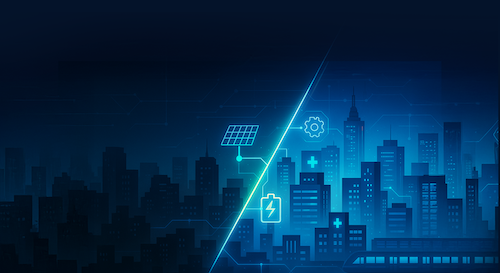Just before dawn, when Mumbai is at its most fragile—streetlights dimming, the city caught between sleep and stir—a tremor brushes the Western Grid. Elsewhere, cities brace for a flicker. But in Mumbai, there is none. No alarms. No plunges into darkness. Power flows, unbroken. Substations pivot, generators shift—and the city stays lit. This is intentional islanding: the deliberate isolation of a city's grid from the national network, enabling local power generation to independently sustain critical services. It is not just a backup plan—it is a survival strategy for an increasingly strained grid, stressed by climate extremes, rising demand, and legacy infrastructure. At its heart lies one invisible yet essential metric: frequency.
India's grid operates at 50 Hz. A dip below 49 Hz signals demand outrunning supply—often triggered by a large plant tripping or spiking loads. When that happens, automatic load-shedding cuts off the non-essential services. But when instability persists, cities like Mumbai switch to islanding: the local assets take over to keep the city going. With embedded generation from Trombay Thermal, Dahanu Thermal, and Khopoli Hydro, plus 16 interconnections forming a meshed network, Mumbai has islanded successfully in 27 out of 37 major disturbances on the Western Grid since 1981, according to the Western Regional Load Dispatch Centre1. Each time, metros ran, hospitals hummed, data centres stayed live. Infrastructure and foresight combined.
Understanding Islanding: Architecture and Autonomy
Islanding is more than a circuit-breaker response—it is a structural capability. In conventional power systems, cities are tied into vast regional grids. These networks, while efficient, also concentrate risk: a transmission fault in one state can propagate disruptions across hundreds of kilometres. Islanding mitigates this by creating a fallback layer: a localised circuit with autonomous generation, isolated from grid-wide instability.
Critically, islanding is not a wholesale disconnection. Rather, it is a selective segmentation, wherein a city—or a critical district—preserves functionality through embedded generation, automation, and switchgear that detects imbalances in real time. It requires not just power plants, but planning: synchronisation systems, load-balancing, storage buffers, and redundancy in transmission paths.
Mumbai: A Template of Organic Resilience
Mumbai's ability to island is not accidental. It is the outcome of architectural diversity and geographic proximity. The city draws from multiple sources—hydroelectric, thermal, and gas-based generation—strategically placed within or near the municipal boundary. These are interconnected through a meshed internal grid that allows load to shift dynamically, ensuring no single point of failure disables the whole system.
In several Western Grid disturbances, this topology has enabled the city to operate in an autonomous mode while adjoining regions experienced outages. The existence of fallback pathways, aided by real-time automation, has allowed the city to protect critical services—metros, water pumps, emergency rooms—even during grid stress events.
This model of organic resilience, forged over decades, is now emerging as a strategic imperative for other metros.
Delhi: Building the Foundation
Delhi offers a contrasting example—not of deficiency, but of different evolution. The capital's grid is structured primarily around bulk transmission. It is powered by large-scale stations such as the Bawana CCGT, Pragati-I (~330 MW), and Pragati-III (~1,500 MW)2, with supply drawn from states including Uttar Pradesh, Punjab, and Haryana. This design emphasises scale and thermal efficiency but offers limited fallback if upstream links fail. Delhi's substations are largely radial, positioned at the termini of supply corridors. During transmission collapse, multiple substations can be affected simultaneously. In the absence of sufficient embedded generation or mesh redundancy, the city has less flexibility to segment or self-sustain.
Nonetheless, Delhi is moving toward distributed resilience. Between 2019 and 2022, a Tata Power-DDL pilot in Civil Lines and Pitampura explored microgrid islanding, integrating rooftop solar, battery storage, and SCADA-based automation3. These are promising steps—incremental but important—in creating decentralised energy clusters within the city.
The Challenge of Urban Density
Delhi's case also underscores a broader constraint: spatial saturation. In dense urban environments, the potential for deploying distributed energy resources (DERs) is often curtailed by land scarcity, shadow coverage, and the lack of regulatory enablers for rooftop solar or battery storage.
India's total installed battery energy storage system (BESS) capacity stood at approximately 442 MWh as of March 20244. A pipeline of 13.2 GWh is supported by viability gap funding5, but this remains largely in the development stage. Until BESS and rooftop solar adoption scales operationally, intra-city islanding will remain technically complex for cities without embedded supply or available space.
Emerging Urban Experiments
Despite these constraints, a quiet transformation is underway. In Bangalore's Whitefield technology corridor, select campuses now operate with DER-BESS clusters capable of limited islanding. Smart City initiatives in Kevadia and Palava are exploring similar frameworks6. These efforts are small in scale but represent a larger trend: the move from blackout mitigation to grid autonomy.
The 2024–25 Union Budget marked this shift with a ₹1.5 lakh crore allocation in interest-free loans for infrastructure reforms—a 27% increase over the previous year7. Energy resilience—via DER integration, grid modernisation, and BESS deployment—is among the focus areas. These investments are not stand-alone—they complement the National Smart Grid Mission and various state-level reforms focused on adaptive energy infrastructure.
Policy Anchors for a Decentralised Grid
Beneath the quiet momentum toward islanded cities lies a scaffolding of national policy. The PM KUSUM scheme, though launched to solarise agricultural pumps, is also seeding decentralised solar assets with latent potential for urban energy autonomy. As of early 2025, India had installed over 4,200 MW across all components, though Component A—which targets feeder-level solar plants—has added around 563 MW so far8. Still, the growth of decentralised solar lays a foundation for embedded generation clusters in peri-urban regions.
In FY 2023–24, India attracted approximately USD 3.76 billion in renewable energy foreign direct investment—an improvement over previous years. The International Energy Agency estimates that USD 68 billion per annum is required to meet the 500 GW by 2030 target9. Bridging this capital gap is essential—not only for utility-scale projects but for the embedded infrastructure that underpins islanding: microgrids, rooftop generation, smart substations, and battery storage. These are assets that require patient capital, long-term visibility, and regulatory clarity. In that context, foreign equity and blended finance will be as critical as generation capacity.
Global Signals: Learning from International Models
Worldwide, energy resilience is being reimagined. After the Fukushima disaster, Tokyo overhauled its distribution framework, reducing outage risk by nearly 40% in priority districts10. Puerto Rico, repeatedly impacted by hurricanes, now mandates microgrids in essential facilities. Sri Lanka, recovering from a 2022 grid collapse, has pivoted toward decentralised control.
These models are not prescriptive, but they are instructive. They show that resilience need not mean redundancy at all costs. Instead, it can be modular, smart, and localised tailored to each city's geography, density, and risk profile.
India's approach—rooted in policy, pilot projects, and targeted capital—reflects a considered progression toward such resilience, suited to its urban and energy context.
The Islanded Future
The need for resilient urban grids is not hypothetical. India's peak demand reached 250 GW in May 2024, with only a 2 MW shortfall11. By 2030, the country's data centre capacity will quadruple, crossing 4,500 MW and attracting $20–25 billion in investment12. These are infrastructure assets with zero tolerance for power interruption. For them, even a five-minute blackout can have cascading consequences.
In this new paradigm, grid resilience is not defined by capacity alone. It is a choreography—where substations anticipate, circuits adjust, and cities continue to hum when the wider network stumbles.
As India urbanises and digitises, its cities will not merely consume power; they will shape the grid itself. Resilience will no longer be a reactive feature, but a built-in layer—designed with the same intent as roads, water systems, or transit lines.
The islanded city is not a contingency. It is the next chapter in the story of sustainable urban growth.
This blog is written by Aashee Sharma

